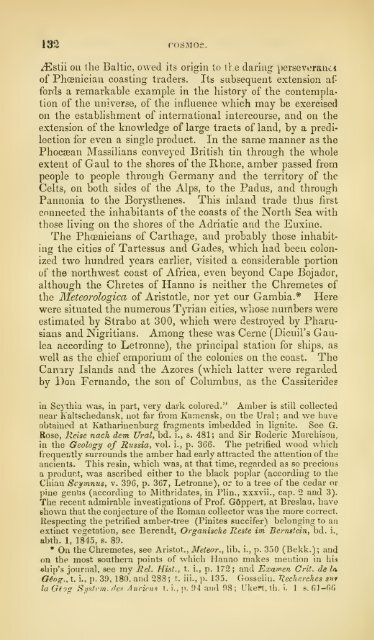See the complete document here
See the complete document here
See the complete document here
Create successful ePaper yourself
Turn your PDF publications into a flip-book with our unique Google optimized e-Paper software.
132 COSMOS.<br />
iEstii on <strong>the</strong> Baltic, owed its origin to <strong>the</strong> daring persevi?ranc«<br />
of Phoenician coasting traders. Its subsequent extension af-<br />
fords a remarkable example in <strong>the</strong> history of <strong>the</strong> contemplation<br />
of <strong>the</strong> universe, of <strong>the</strong> influence which may be exercised<br />
on <strong>the</strong> establishment of international intercourse, and on <strong>the</strong><br />
extension of <strong>the</strong> knowledge of large tracts of land, by a predilection<br />
for even a single product. In <strong>the</strong> same manner as <strong>the</strong><br />
Phocsean Massilians conveyed British tin through <strong>the</strong> whole<br />
extent of Gaul to <strong>the</strong> shores of <strong>the</strong> Rhone, amber passed from<br />
people to people through Germany and <strong>the</strong> territory of <strong>the</strong><br />
Celts, on both sides of <strong>the</strong> Alps, to <strong>the</strong> Padus, and through<br />
Pannonia to <strong>the</strong> Borys<strong>the</strong>nes. This inland trade thus first<br />
connected <strong>the</strong> inhabitants of <strong>the</strong> coasts of <strong>the</strong> North Sea with<br />
those living on <strong>the</strong> shores of <strong>the</strong> Adriatic and <strong>the</strong> Euxine.<br />
The Phoenicians of Carthage, and probably those inhabit-<br />
inof <strong>the</strong> cities of Tartessus and Gades, which had been colon-<br />
ized two hundred years earlier, visited a considerable portion<br />
of <strong>the</strong> northwest coast of Africa, even beyond Cape Bojador,<br />
although <strong>the</strong> Chretes of Hanno is nei<strong>the</strong>r <strong>the</strong> Chremetes of<br />
<strong>the</strong> Meteorologico, of Aristotle, nor yet our Gambia.* Here<br />
were situated <strong>the</strong> numerous Tyrian cities, whose numbers were<br />
estimated by Strabo at 300, which were destro^-ed by Pharusians<br />
and Nigritians. Among <strong>the</strong>se was Cerne (Dicuil's Gau-<br />
lea according to Letronne), <strong>the</strong> principal station for ships, as<br />
well as <strong>the</strong> chief emporium of <strong>the</strong> colonies on <strong>the</strong> coast. The<br />
Can'iry Islands and <strong>the</strong> Azores (which latter were regarded<br />
by Don Fernando, <strong>the</strong> son of Columbus, as <strong>the</strong> Cassiteride?<br />
in Scythia was, iu part, very dark colored." Amber is still collected<br />
near K'altscbedansk, not far from Kamensk, on <strong>the</strong> Ural ; and we have<br />
obtained at Katharinenburg fragments imbedded in lignite. <strong>See</strong> G.<br />
Rose, lleise nach dem Ural, bd. i., s. 481; and Sir Roderic Murchison,<br />
in <strong>the</strong> Geology of Russia, vol. i., p. 3C6. The petrified w'ood which<br />
frequently surrounds <strong>the</strong> amber had early attracted <strong>the</strong> attention of <strong>the</strong><br />
ancients. This resin, which was, at that time, regarded as so precious<br />
a product, was ascribed ei<strong>the</strong>r to <strong>the</strong> black poplar (according to <strong>the</strong><br />
Chian Scymnus, v. 396, p. 367, Letronne), or to a tree of <strong>the</strong> cedar or<br />
pine genUs (according to Mithridates, in Plin., xxxvii., cap. 2 and 3).<br />
The recent admirable investigations of Prof. G6ppert, at Breslau, have<br />
Bhown that <strong>the</strong> conjecture of <strong>the</strong> Roman collector was <strong>the</strong> more coirect.<br />
Respecting <strong>the</strong> petrified amber-tree (Pinites succifer) belonging to an<br />
extinct vegetation, see Berendt, Organische Reste im Bernstein, bd. i.,<br />
abth. 1, 1845, s. 89.<br />
* On <strong>the</strong> Chremetes, see Aristot., Meteor., lib. i., p. 350 (Bekk.); and<br />
on <strong>the</strong> most sou<strong>the</strong>rn points of which Hanno makes mention in hia<br />
«hi[)'s journal, see my Rel. Hist., t. i., p. 172; and Examen Crit. de Ic,<br />
Giog., t. i., p. 39, 180, and 288; t. iii., p. 135. Gosselin. Reckerches svf<br />
la Giog System, den Ancienx t. i., n. 94 and 08; Ukeft, th. i. 1 s. 6] -66
















